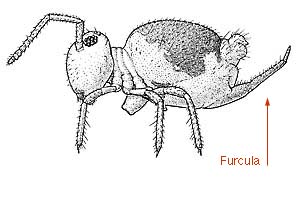|
The order Collembola contains individuals commonly called springtails. They are very primitive and we find them in a diversity of habitats. They may be as small as 0.25 mm, and sometimes may be close to 10 mm long. Most species are one to three mm in total length.
Springtails demonstrate ametabolous metamorphosis because they don't really change when they molt. Springtails develop from egg to young to an adult. They have no wings and are described as having chewing mouthparts. Springtails derive their name from a structure (you can see on the line illustration connected to this order) that extends from the tip of their abdomen. This structure is called the furcula. It folds up underneath the body, and when the insect wants to move forward, the furcula is released and the springtail is propelled forward.
We know that there are about 6,000 different species in the world. In North America north of Mexico, there is just slightly fewer than 700 different species. This rather primitive group of organisms may be quite abundant when soils are rich in organic material. In forest soils, springtails have been reported to be as abundant as 10,000/m2. You may have witnessed snow becoming blackened on the surface, usually during a January thaw event. The tiny black insects that congregate on the soil surface are a species of springtail commonly referred to as snowfleas. Obviously this is not a true flea but a member of the order Collembola. |

Springtail
Order: Collembola
Family: Sminthuridae
|
